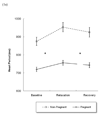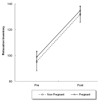Physiological blunting during pregnancy extends to induced relaxation
- PMID: 21802489
- PMCID: PMC3212610
- DOI: 10.1016/j.biopsycho.2011.07.005
Physiological blunting during pregnancy extends to induced relaxation
Abstract
There is accumulating evidence that pregnancy is accompanied by hyporesponsivity to physical, cognitive, and psychological challenges. This study evaluates whether observed autonomic blunting extends to conditions designed to decrease arousal. Physiological and psychological responsivity to an 18-min guided imagery relaxation protocol in healthy pregnant women during the 32nd week of gestation (n=54) and non-pregnant women (n=28) was measured. Data collection included heart period (HP), respiratory sinus arrhythmia (RSA), tonic and phasic measures of skin conductance (SCL and NS-SCR), respiratory period (RP), and self-reported psychological relaxation. As expected, responses to the manipulation included increased HP, RSA, and RP and decreased SCL and NS-SCR, followed by post-manipulation recovery. However, responsivity was attenuated for all physiological measures except RP in pregnant women, despite no difference in self-reported psychological relaxation. Findings support non-specific blunting of physiological responsivity during pregnancy.
Copyright © 2011 Elsevier B.V. All rights reserved.
Figures






Similar articles
-
Fetal responses to induced maternal relaxation during pregnancy.Biol Psychol. 2008 Jan;77(1):11-9. doi: 10.1016/j.biopsycho.2007.08.008. Epub 2007 Aug 31. Biol Psychol. 2008. PMID: 17919804 Free PMC article.
-
Respiratory sinus arrhythmia as an index of emotional response in young adults.Psychophysiology. 2004 Jan;41(1):75-83. doi: 10.1046/j.1469-8986.2003.00131.x. Psychophysiology. 2004. PMID: 14693002
-
Maternal psychophysiological change during the second half of gestation.Biol Psychol. 2005 Apr;69(1):23-38. doi: 10.1016/j.biopsycho.2004.11.003. Epub 2005 Jan 4. Biol Psychol. 2005. PMID: 15740823
-
Respiratory sinus arrhythmia: autonomic origins, physiological mechanisms, and psychophysiological implications.Psychophysiology. 1993 Mar;30(2):183-96. doi: 10.1111/j.1469-8986.1993.tb01731.x. Psychophysiology. 1993. PMID: 8434081 Review.
-
Respiratory and cardiac rhythms as windows to central and autonomic biobehavioral regulation: selection of window frames, keeping the panes clean and viewing the neural topography.Biol Psychol. 1992 Nov;34(2-3):131-61. doi: 10.1016/0301-0511(92)90013-k. Biol Psychol. 1992. PMID: 1467391 Review.
Cited by
-
Physiological reactivity to psychological stress in human pregnancy: current knowledge and future directions.Prog Neurobiol. 2012 Nov;99(2):106-16. doi: 10.1016/j.pneurobio.2012.07.003. Epub 2012 Jul 16. Prog Neurobiol. 2012. PMID: 22800930 Free PMC article. Review.
-
The impact of healthy pregnancy on features of heart rate variability and pulse wave morphology derived from wrist-worn photoplethysmography.Sci Rep. 2023 Nov 30;13(1):21100. doi: 10.1038/s41598-023-47980-2. Sci Rep. 2023. PMID: 38036597 Free PMC article.
-
Intergenerational transmission of emotion dysregulation: Part I. Psychopathology, self-injury, and parasympathetic responsivity among pregnant women.Dev Psychopathol. 2019 Aug;31(3):817-831. doi: 10.1017/S0954579419000336. Epub 2019 May 8. Dev Psychopathol. 2019. PMID: 31064587 Free PMC article.
-
Maternal psychophysiology profiles: associations with prenatal opioid use, maternal emotion dysregulation, and newborn neurobehavior.Pediatr Res. 2025 Feb;97(3):1155-1165. doi: 10.1038/s41390-024-03399-7. Epub 2024 Aug 3. Pediatr Res. 2025. PMID: 39097654 Free PMC article.
-
Influences of adversity across the lifespan on respiratory sinus arrhythmia during pregnancy.Dev Psychobiol. 2021 Sep;63(6):e22132. doi: 10.1002/dev.22132. Epub 2021 May 30. Dev Psychobiol. 2021. PMID: 34053065 Free PMC article.
References
-
- Allen JJB, Chambers AS, Towers DN. The many metrics of cardiac chronotropy: A pragmatic primer and a brief comparison of metrics. Biological Psychology. 2007;74:243–262. - PubMed
-
- Baker F, Denniston M, Zabora J, Polland A, Dudley WN. A POMS short form for cancer patients: Psychometric and structural evaluation. Psycho-Oncology. 2002;11:273–281. - PubMed
-
- Barron W, Mujais S, Zinaman M, Bravo E, Lindheimer M. Plasma catecholamine responses to physiologic stimuli in normal human pregnancy. American Journal of Obstetrics and Gynecology. 1986;154:80–84. - PubMed
-
- Beddoe EA, Lee KA. Mind-body interventions during pregnancy. Journal of Obstetric, Gynecologic and Neonatal Nursing. 2008;37:165–175. - PubMed
-
- Berntson G, Cacioppo J, Quigley K. Respiratory sinus arrhythmia: Autonomic origins, physiological mechanisms, and psychophysiological implications. Psychophysiology. 1993;30:183–196. - PubMed
Publication types
MeSH terms
Grants and funding
LinkOut - more resources
Full Text Sources
Medical
Research Materials
Miscellaneous

